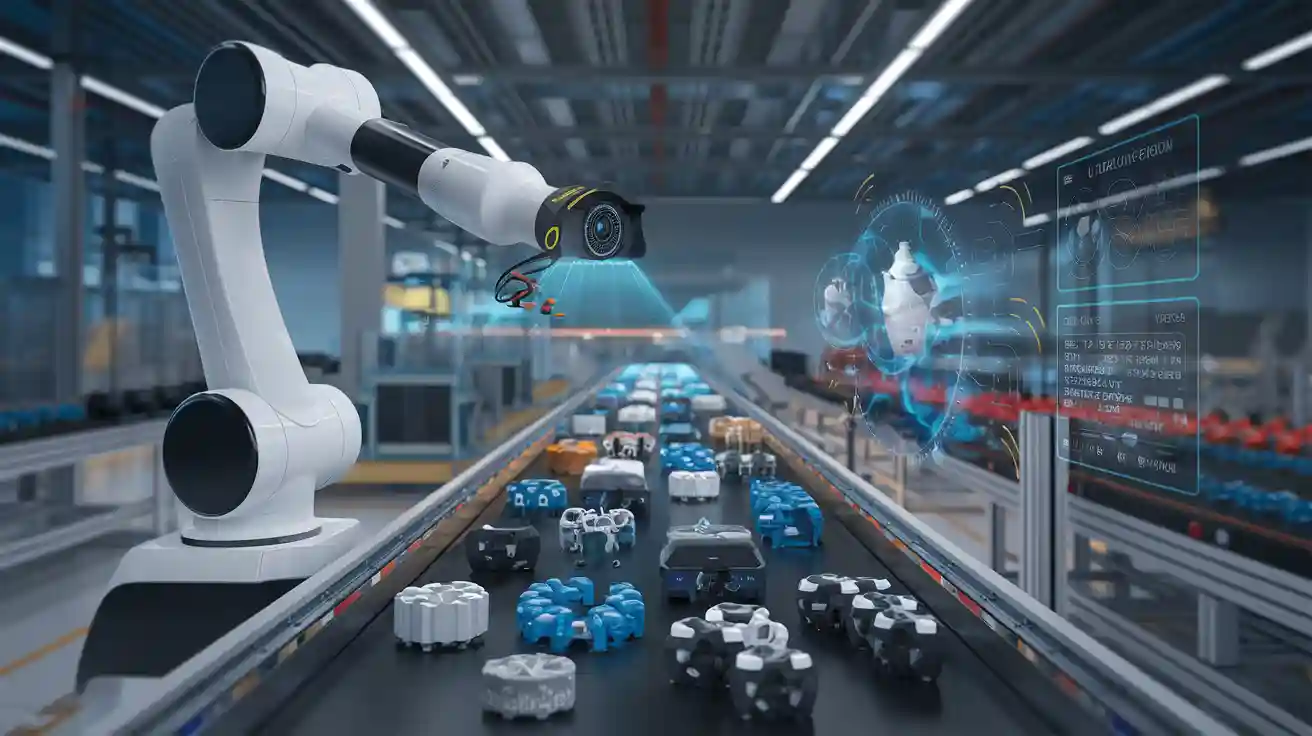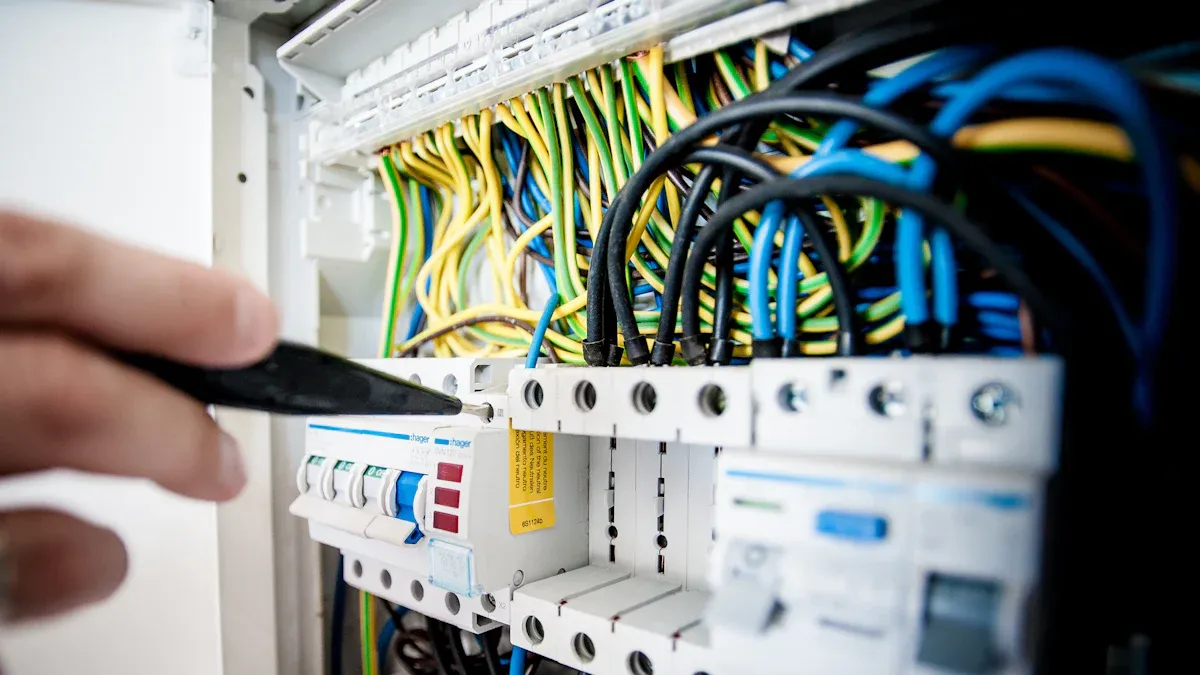What Machine Vision Systems Offer for Defect Detection

You can rely on a defect detection machine vision system to revolutionize quality control in your operations. These systems combine advanced imaging with artificial intelligence to spot imperfections instantly. They work faster and more accurately than manual inspections, helping you maintain high-quality standards. By automating defect detection, you reduce human error and boost efficiency. This technology also ensures cost savings by minimizing waste and improving productivity. Whether you work in manufacturing, electronics, or food production, machine vision systems enhance both your processes and customer satisfaction.
Key Takeaways
- Machine vision systems find defects faster and better than people.
- Adding AI and machine learning helps them get smarter over time.
- These systems can reach over 99% accuracy and save money.
- They check for problems right away, fixing them quickly to save time.
- Automated tools lower mistakes, make work easier, and boost efficiency.
- Buying this technology costs money at first but saves more later.
- It cuts waste, follows rules, and makes customers happier.
Understanding Defect Detection Machine Vision Systems
Definition and Purpose
A defect detection machine vision system plays a critical role in quality control. It identifies flaws like cracks, scratches, and discoloration that can impact product performance. These systems rely on algorithms to analyze patterns and textures, classifying defects by type and size. With the ability to measure features as small as 25.4 microns, they ensure precise dimensional accuracy and geometric tolerances. This level of precision helps you maintain high product standards while reducing waste and improving efficiency.
Core Components of a Defect Detection System
Every defect detection system includes essential components that ensure reliability and performance:
- Automated Inspection Systems: Cameras and sensors perform real-time inspections to detect physical defects.
- Statistical Process Control (SPC): Statistical methods monitor processes, reducing the likelihood of defects.
- Intelligent Technology Integration: AI and machine learning enable predictive analytics for defect detection.
- Regular Audits and Checkpoints: Early detection of non-conformities prevents larger issues.
These components work together to create a robust inspection system that delivers consistent results.
How Defect Detection Systems Operate
Defect detection systems use advanced sensors and algorithms to monitor and analyze materials in real time. For example, optical sensors capture high-resolution images to assess surface conditions, while temperature and pressure sensors track environmental factors. The table below highlights key sensors and their functions:
| Type of Sensor | Function |
|---|---|
| Temperature Sensors | Measure equipment and material temperatures |
| Pressure Sensors | Monitor gas pressures in etching or deposition |
| Electrical Sensors | Track electrical signals and currents |
| Optical Sensors | Use imaging techniques for surface condition monitoring |
Data acquisition methods, such as direct measurement and data logging, ensure accurate information collection. Algorithms like machine learning and SPC analyze this data to identify defects quickly and efficiently. By automating these processes, you can achieve faster inspections and higher accuracy, reducing downtime and improving productivity.
Key Features of Automated Defect Detection

High-Resolution Imaging Technology
High-resolution imaging technology forms the backbone of automated defect detection systems. It allows you to capture intricate details of a product's surface, ensuring even the smallest flaws are identified. These systems use advanced cameras and optical sensors to achieve unparalleled precision. For instance, they can detect scratches, cracks, or discoloration that might escape the human eye.
The effectiveness of high-resolution imaging is evident in its ability to improve accuracy significantly. Consider the following data:
| Measurement Type | Accuracy Improvement (%) |
|---|---|
| Scratch Depth Measurement | 69.3 to 98.1 |
Additionally, methods like Convolutional Neural Networks (CNNs) and Alternating Current (AC) imaging have demonstrated remarkable results:
| Method | Detection Error (%) | Overall Accuracy (%) |
|---|---|---|
| AC (Alternating Current) | 11.7 - 14.2 | 98 |
| CNN (Convolutional Neural Network) | N/A | 98 |
By leveraging this technology, you can ensure consistent quality control and reduce the risk of defective products reaching your customers.
AI and Machine Learning Integration
Artificial intelligence and machine learning have revolutionized defect detection by enabling systems to learn and adapt over time. These technologies analyze vast amounts of data to identify patterns and anomalies with exceptional speed and accuracy. Unlike traditional methods, AI-driven systems continuously improve their performance, making them ideal for dynamic production environments.
The measurable benefits of AI integration are striking:
| Metric | Traditional Methods | AI-Driven Systems |
|---|---|---|
| Accuracy | 85-90% | 99.5%+ |
| Speed | 2-3 seconds/unit | 0.2 seconds/unit |
| Cost Efficiency | $12K/month | $4K/month |
| Scalability | Limited by workforce | Handles 10x volume spikes |
For example:
- A consumer electronics team reduced defect rates by 75% using automated visual inspection systems, processing 500 units per minute.
- An automotive supplier decreased inspection costs by 62% with vision technology, resulting in 78% fewer returns.
By integrating AI into your defect detection processes, you can achieve higher accuracy, faster inspections, and significant cost savings.
Real-Time Analysis and Feedback Mechanisms
Real-time analysis and feedback mechanisms are critical for maintaining efficient production lines. These systems process data instantly, allowing you to identify and address defects as they occur. This minimizes downtime and prevents defective products from advancing further in the production cycle.
Advanced models like CBS-YOLOv8 exemplify the power of real-time defect detection. This model achieves a mean Average Precision (mAP) of 97.4% and operates at an inference speed of 79.25 frames per second (FPS). On another dataset, it achieved a mAP50 of 99.3%, showcasing its versatility and effectiveness.
With real-time feedback, you can make immediate adjustments to your processes, ensuring optimal product quality. This capability not only enhances operational efficiency but also reduces waste and improves customer satisfaction.
Benefits of Defect Detection Machine Vision Systems
Enhanced Accuracy and Consistency
Defect detection machine vision systems provide unmatched accuracy and consistency in identifying flaws. These systems categorize defects into five main types: missingness, incorrectness, syntax violation, semantic violation, and duplication. By addressing these issues, you can maintain high data quality and ensure product integrity.
The ability to consistently detect and classify defects reduces errors caused by human oversight. For example, computer vision technology analyzes patterns and textures with precision, ensuring that even the smallest imperfections are identified. This level of control helps you deliver products that meet strict quality assurance standards.
Continuous improvement in data quality is essential for maintaining accuracy. Challenges such as software updates, user errors, and accidental mistakes can impact your processes. Automated defect detection systems adapt to these changes, ensuring consistent performance over time.
Cost Savings Through Automation
Automated defect detection significantly reduces costs by streamlining your quality assurance processes. While the initial investment includes tools, training, and setup, the long-term savings outweigh these expenses. The table below highlights the cost structure:
| Category | Details |
|---|---|
| Initial Investment | Automation tools, training, setup, and script creation |
| Ongoing Costs | Maintenance, cloud infrastructure, continuous learning |
| Cost Savings | Reduced manual testing hours, faster time-to-market, fewer post-release bugs |
By automating quality control, you minimize the need for manual inspections, which are time-consuming and prone to errors. Automated quality assurance systems also reduce the likelihood of defective products reaching customers, saving you from costly recalls or reputational damage.
Increased Productivity and Operational Efficiency
Defect detection systems enhance productivity by optimizing your operations. These systems process large volumes of data quickly, allowing you to identify and address issues without delays. The following table illustrates how these systems improve efficiency:
| Metric | Impact on Productivity |
|---|---|
| Defect Rate | Successful hospitals achieve an average defect rate of 1%. |
| Smart Labor Management | Reduces defects by placing the right personnel in key roles. |
| Continuous Training | Keeps employees updated on best practices for defect prevention. |
| Data Analytics | Identifies problem areas and prevents defects proactively. |
| Supply Chain Management | Reduces defects by ensuring high product quality from the start. |
| Automation | Provides early insights into system vulnerabilities, improving quality. |
By integrating computer vision and automated quality control into your processes, you can achieve faster production cycles and higher output. Real-time feedback mechanisms further enhance operational efficiency by allowing you to make immediate adjustments. This ensures that your production line runs smoothly, reducing downtime and increasing overall productivity.
Applications of Defect Detection Systems Across Industries

Manufacturing and Assembly Line Inspection
Defect detection systems play a vital role in manufacturing quality control. They ensure products meet stringent standards by identifying flaws early in the production process. High-resolution cameras and computer vision models detect small abnormalities, such as surface defects or assembly errors, that could compromise safety or functionality.
These systems also enhance efficiency through real-time monitoring. For example, automated visual inspection tools can achieve an average detection rate of 92.64%, with a misjudgment rate of only 6.68%. This level of precision reduces waste and improves overall productivity.
Manufacturing plants benefit from diverse applications, including:
- Surface Profiling: Detects scratches, dents, and other surface defects.
- End-of-Line Testing: Ensures assemblies function correctly before shipping.
- Welding Monitoring: Analyzes welding variables to prevent structural issues.
By integrating defect detection systems, you can streamline operations and maintain high-quality standards across your assembly lines.
Electronics and Semiconductor Quality Control
Electronics and semiconductor industries demand exceptional precision due to the microscopic scale of their components. Traditional manual inspections often struggle to detect complex defects, leading to inefficiencies and increased costs. Defect detection systems address these challenges by leveraging computer vision and AI technologies.
A global electronics manufacturer implemented an AI-enabled defect detection system to improve inspection efficiency. This solution reduced missed defects by 30%, cut inspection cycle time by 40%, and saved over $2 million annually. Such advancements highlight the transformative impact of custom defect detection systems in this sector.
Key applications include:
- Crimp Monitoring: Avoids destructive testing by ensuring proper connections.
- Leak Testing: Provides real-time visibility into defects.
- Dispensing: Monitors adhesive and sealant applications for accuracy.
By adopting these systems, you can enhance manufacturing quality control, reduce errors, and optimize production processes.
Automotive Defect Detection Systems
The automotive industry relies heavily on defect detection systems to ensure vehicle safety and performance. These systems utilize computer vision and predictive analytics to identify flaws in auto parts, monitor production processes, and optimize preventive maintenance strategies.
For instance, BMW uses machine learning models to generate visual heatmaps for fault detection, improving repair efficiency. Volvo Trucks reduced diagnostic time by 70% and repair time by 25% through real-time data analysis. These examples demonstrate the significant benefits of integrating defect detection systems into automotive manufacturing.
Applications include:
- Surface Defect Identification: Detects scratches, dents, and paint imperfections.
- Engine and Transmission Error Estimation: Predicts potential issues before they occur.
- Production Process Monitoring: Ensures timely follow-up of assembly processes.
By implementing these systems, you can enhance vehicle quality, reduce waste, and improve customer satisfaction.
Food and Beverage Industry Applications
Defect detection systems have become essential in the food and beverage industry. These systems help you maintain high product quality by identifying defects that could compromise safety or consistency. Advanced imaging and AI technologies ensure that every item meets strict standards before reaching your customers.
One of the most significant advantages of these systems is their ability to ensure consistent product quality. Automated inspection tools detect imperfections such as contamination, packaging errors, or irregularities in shape and size. This consistency strengthens your brand's reliability and builds customer loyalty.
Regulatory compliance is another critical area where defect detection systems excel. They validate process controls to ensure adherence to safety regulations like FDA, HACCP, and GFSI standards. By using these systems, you can reduce the risk of non-compliance and avoid costly penalties.
The table below highlights key benefits of defect detection systems in this sector:
| Benefit | Description |
|---|---|
| Consistent Product Quality | Ensures uniformity in products, enhancing brand reliability and customer loyalty. |
| Regulatory Compliance and Risk Management | Validates process controls, ensuring adherence to safety regulations (FDA, HACCP, GFSI). |
| Cost Reduction Through Waste Minimization | High Cp and Cpk indicate well-controlled processes, reducing defects, recalls, and production waste. |
Automated systems also help you minimize waste and reduce costs. AI-powered tools can scan thousands of items per minute, identifying even the smallest imperfections. This precision prevents defective products from advancing through the supply chain, saving you money on recalls and production waste.
By integrating defect detection systems into your operations, you can achieve higher efficiency, better compliance, and improved customer satisfaction. These systems not only protect your brand but also ensure that your products meet the highest safety and quality standards.
Challenges and Considerations in Implementing Defect Detection Systems
Initial Implementation Costs
Adopting a defect detection system requires a significant upfront investment. Advanced equipment, such as high-resolution cameras and computer vision platforms, forms the backbone of these systems. Integrating them into your production line may also demand infrastructure upgrades. For example, a low-cost Nvidia GF750 setup costs around €700 but offers limited GPU memory, making it suitable only for small applications. On the other hand, high-end training stations with multiple Nvidia P106-100 GPUs deliver superior performance for large-scale operations but come with higher costs.
| Hardware Setup | Cost (EUR) | Performance Characteristics |
|---|---|---|
| Low-cost Nvidia GF750 | 700 | Suitable for small applications, limited GPU memory |
| High-end training station (4 Nvidia P106-100) | N/A | High performance, suitable for large-scale applications, higher cost |
While the initial costs may seem daunting, the long-term benefits outweigh the investment. Automation reduces labor expenses, lowers scrap rates, and minimizes rework costs. These savings contribute to a strong return on investment over time.
Tip: Carefully evaluate your production needs and budget before selecting a defect detection system. Balancing cost and performance ensures optimal results.
System Complexity and Maintenance Requirements
Defect detection systems often involve complex setups that require regular maintenance. Advanced computer vision algorithms and machine learning models demand consistent updates to maintain accuracy. Operational data highlights the impact of these systems on defect density, cycle time, and customer satisfaction:
| Metric | Before Data Mining | After Data Mining | Improvement |
|---|---|---|---|
| Defect Density (per KLOC) | 4.2 | 2.3 | 45.2% |
| Cycle Time (days) | 24.7 | 17.8 | 27.9% |
| Estimation Accuracy | 63.5% | 84.2% | 32.6% |
| Customer Satisfaction | 72% | 86% | 19.4% |
| Maintenance Cost (% of dev budget) | 37% | 29% | 21.6% |
Regular maintenance ensures consistent performance and reduces downtime. However, it also adds to operational costs. You must allocate resources for software updates, hardware servicing, and system calibration to keep your defect detection system running smoothly.
Training and Integration with Existing Processes
Training your team is essential for the successful adoption of defect detection systems. Machine learning models enhance automation, allowing you to identify even the smallest defects that human inspectors might miss. These models maintain consistent performance over time, unaffected by fatigue, which ensures reliable integration into your existing processes.
Key benefits of training and integration include:
- Machine learning improves efficiency and reduces costs.
- Trained algorithms detect material defects with higher accuracy.
- Automated systems deliver consistent results, supporting long-term reliability.
Proper training equips your team to handle system complexities and maximize its potential. Integration with existing workflows requires careful planning to avoid disruptions. By investing in training and aligning processes, you can achieve seamless adoption and improved operational efficiency.
Defect detection machine vision systems redefine quality control with unmatched precision and speed. These systems outperform human inspections, completing tasks 80 times faster while achieving a recall of 100% and an F1 score of 92.02%. Industries like manufacturing and electronics benefit from consistent defect identification and improved operational efficiency. NTT DoCoMo reported a 34% improvement in defect detection after integrating AI. While initial costs and complexity pose challenges, the long-term advantages make these systems a valuable investment for businesses seeking reliable and scalable solutions.
FAQ
What types of defects can machine vision systems detect?
Machine vision systems can detect surface flaws like scratches, dents, and discoloration. They also identify structural issues, missing components, and alignment errors. Advanced systems even spot microscopic defects in electronics or semiconductors.
How accurate are defect detection systems compared to manual inspections?
Defect detection systems achieve over 99% accuracy, far surpassing manual inspections. They eliminate human error and maintain consistent performance, even during high-speed production.
Are these systems suitable for small businesses?
Yes, many systems offer scalable solutions for small businesses. Entry-level setups provide cost-effective options, allowing you to improve quality control without significant upfront investment.
How do these systems handle real-time defect detection?
Real-time systems process data instantly using high-speed cameras and AI algorithms. They identify defects as they occur, enabling immediate corrective actions and minimizing production delays.
Do defect detection systems require frequent maintenance?
Regular maintenance ensures optimal performance. Tasks include software updates, hardware calibration, and cleaning sensors. However, modern systems are designed for durability, reducing the frequency of maintenance.
Tip: Schedule periodic checks to keep your system running smoothly and avoid unexpected downtime.
See Also
Investigating Flaw Identification Within Machine Vision Technologies
Ensure Flaw Detection Using Verification Machine Vision Solutions
Analyzing Defect Recognition Through Machine Vision Techniques
Improving Product Quality With Surface Inspection Vision Systems
